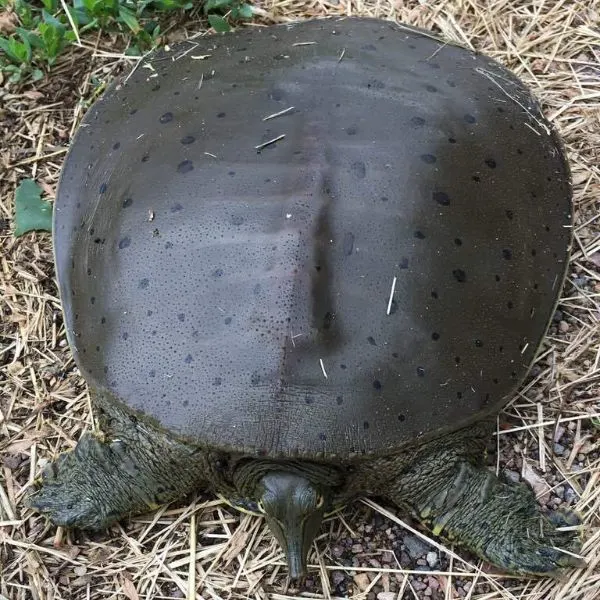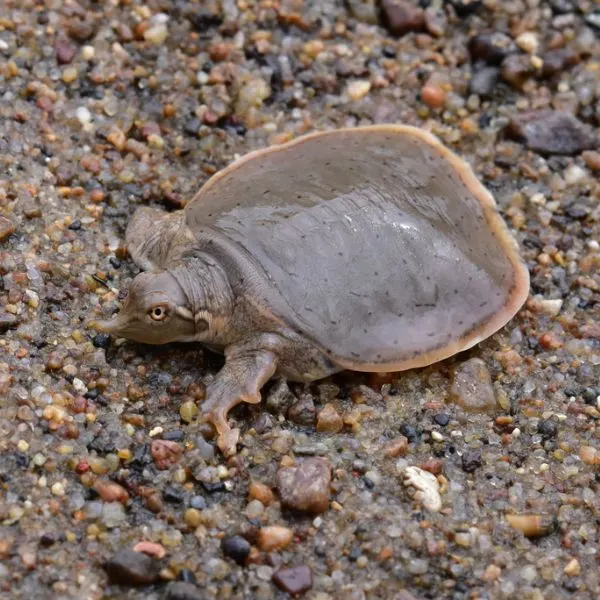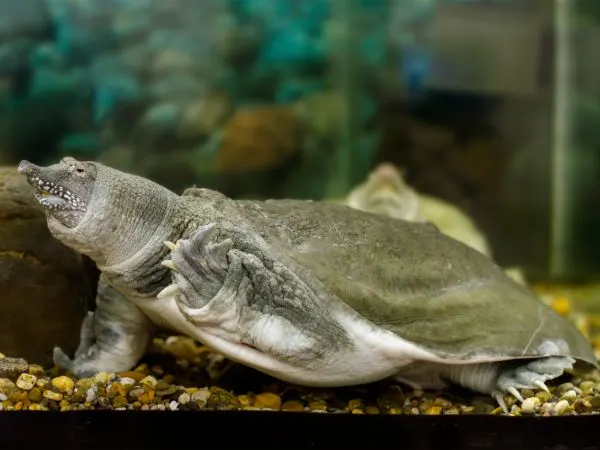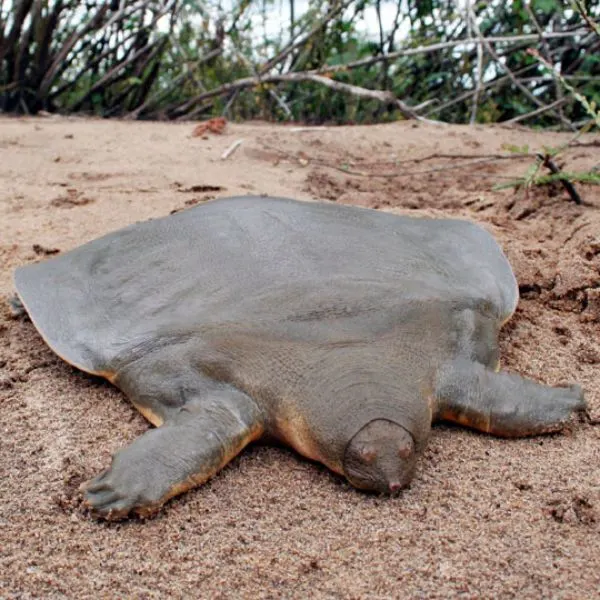Softshell turtles refer to turtles of the family Trionychidae. These turtles have no hard shells instead they have tough leathery skin, thus the name – softshell turtles.
These turtles are among the largest freshwater turtles in the world. The most popular softshell turtles kept as pets include turtles of the Genus Apalone.
This genus includes three North American freshwater turtles. These are the Florida softshell turtle, the spiny softshell turtle, and the smooth softshell turtle.
Quick Reference Section
- Experience Level: Intermediate to Expert
- Family: Trionychidae
- Average Adult Size: 10 inches to 3.3 feet
- Lifespan: 50 to 100 years depending on species
- Clutch Size: 1 to 33 eggs
- Egg Incubation Period: 8 to 12 weeks
- Food: Aquatic turtle food, insects and low-fat meat
- Tank Size: 75 – 600 gallons (depending on size/gender)
- Average Temperature: 85°H/75°L
- UVB Lighting: Needed
- Average Price Range: $50 to $150
- Conservation Status: From Least concern to extinct in the wild, depending on the species
Table of Contents
- Softshell Turtle Species
- Other Softshells That Don’t Belong To The Genus Apalone
- Softshell Turtle Habitat
- Feeding the Softshell Turtle
- Temperament & Handling
- Softshell Turtle’s Lifespan
- Common Health Concerns
- Pricing and Availability
- Conservation/Threats
Types of Softshell Turtles
1. Florida Softshell turtle

Quick Facts
- Family: Trionychidae
- Scientific Name: Apalone ferox
- Average Female Adult Size: 16 – 24 inches
- Average Male Adult Size: 14 inches
- Tank Size: 75 – 100 gallons (for adult males), 600 gallons (for large adult females)
- Lifespan: 50 years
- Average Price Range: $15 to $40
The Florida softshell turtle is one of the more popular softshell turtles kept as pets. This North American freshwater turtle is endemic to Florida (which gives it its common name), and the southern parts of Texas, Tennessee, Alabama, Georgia, and South Carolina. This turtle’s geographic range spans the entire Florida peninsula.
The Florida softshell turtle has a flat body, long neck, an elongated head, and a snorkel-like nose.
As with most aquatic turtles, the Florida softshell turtle has webbed feet. It has the darkest carapace of softshell turtle species endemic to Florida and whitish cream plastron.
The Florida softshell turtle is one of the most common softshell you can find. They need large tanks, stock tanks, or ponds to be comfortable. Females, in particular, grow to be 29 inches and require an enclosure with a water capacity of 600 gallons or more.
2. Spiny Softshell turtle

Quick Facts
- Family: Trionychidae
- Scientific Name: Apalone spinifera
- Average Female Adult Size: 9 – 11 inches
- Average Male Adult Size: 5 – 9 inches
- Tank Size: 75 – 100 gallons
- Lifespan: 50 years
- Average Price Range: $50 to $150
Among the North American turtles, the spiny softshell turtle and the smooth softshell are the smaller ones. As such, most people prefer to keep the spiny and the smooth softshell turtle as pets.
There are six different subspecies of the Apalone spinifera. These include the Northern spiny softshell turtle (or Eastern spiny softshell, Gulf Coast spiny softshell turtle, Texas spiny softshell turtle, Guadalupe spiny softshell turtle, Pallid spiny softshell turtle, and Black spiny softshell turtle.
Like other softshell turtles, the spiny softshell turtle has webbed feet and three claws. The turtle has yellow-brownish to olive carapace. The plastron on the other hand is whitish-yellow in color.
The spiny softshell turtle needs a tank that is about least 100 gallons in capacity.
3. Smooth Softshell turtle

Quick Facts
- Family: Trionychidae
- Scientific Name: Apalone mutica
- Average Female Adult Size: 7 – 14 inches
- Average Male Adult Size: 5 – 7 inches
- Tank Size: 75 – 100 gallons
- Lifespan: 50 years
- Average Price Range: $50 to $150
The smooth softshell turtle looks very much like the spiny softshell turtle. As such, the two are easily confused. The most distinguishing feature is their shells.
The spiny softshell turtle has a rough carapace with spines along the front edge, while the smooth softshell turtle has a smooth shell.
The smooth softshell turtle also has an unmarked chin and throat while the spiny softshell has a splotchy chin and throat.
Lastly, the smooth softshell turtle is the only North American softshell turtle with round nostrils. Both the Florida and the spiny softshell turtles have C-shaped nostrils.
The smooth softshell turtle can be found from Pennsylvania to New Mexico and Florida (they are found in from central to south central United States). They inhabit the Mississippi, Colorado, Sabine and Pearl, Alabama, Brazos, and Escambia river drainage systems.
As with the spiny softshell turtle, the smooth softshell turtle also needs a fairly large tank to thrive. A tank that is at least 75 to 100 gallons in capacity is recommended.
Other Softshells That Don’t Belong To The Genus Apalone
4. Chinese Softshell turtle

Quick Facts
- Family: Trionychidae
- Scientific Name: Pelodiscus sinensis
- Average Female Adult Size: 13 inches
- Average Male Adult Size: 11 inches
- Tank Size: 75 – 100 gallons
- Lifespan: 25 years
- Average Price Range: $30 to $100
The Chinese softshell turtle may be the most popular Asiatic softshell turtle kept as pets. The albino Chinese softshell turtle is especially sought after. As with all other softshell turtles, the Chinese softshell turtle is an excellent swimmer and predator.
The Chinese softshell turtle has olive carapaces with dark blotches and a reddish-orange plastron with dark blotches. The average length of the Chinese softshell turtle is 10 to 13 inches. The females grow to be larger but not by much.
As with other softshell turtles, the Chinese softshell turtle needs a large tank to thrive. A tank with a capacity of 75 to 100 gallons at least is best.
5. Giant Softshell turtle

Quick Facts
- Family: Trionychidae
- Scientific Name: Pelochelys
- Species: Asian giant softshell turtle (Pelochelys cantorii) or Cantor’s giant softshell turtle, New Guinea giant softshell turtle (Pelochelys bibroni), and Northern New Guinea giant softshell turtle (Pelochelys signifera)
- Adult Size: 3 feet
- Lifespan: 80 to 150 years
- Average Price Range: n/a
The giant softshell turtles are among the biggest freshwater turtles in the world with species growing to over 3 feet in length and over 200 lbs in mass.
These large turtles are endemic to Asia, especially East Asia. The three known species of the genus Pelochelys include the Asian giant softshell turtle, the New Guinea giant softshell turtle, and the Northern New Guinea giant softshell turtle.
The Yangtze giant softshell turtle (Rafetus swinhoei) is another giant Asian turtle although it doesn’t belong to the genus Pelochelys.
The giant softshell turtle species all have threatened statuses.
6. Genus Nilssonia

Quick Facts
- Experience Level: Beginner
- Family: Trionychidae
- Scientific Name: Nilssonia
- Species: Black softshell turtle or Bostami turtle (Nilssonia nigricans), Burmese peacock softshell turtle (Nilssonia formosa), Indian softshell turtle (Nilssonia gangetica) or Ganges softshell turtle, Indian peacock softshell turtle (Nilssonia hurum), and Leith’s softshell turtle (Nilssonia leithii)
- Adult Size: 3 feet
- Average Price Range: n/a
The Nilssonia is a genus of softshell turtles found in India and its neighboring countries. These turtles generally have threatened conservation statuses.
The black softshell turtle is extinct in the wild according to the IUCN. Other nilssonia turtles have endangered or vulnerable conservation statuses. These turtles aren’t kept as pets although several of them are maintained in temple ponds.
Softshell Turtle Care
Softshell Turtle Habitat
Softshell turtles are aquatic species and can be found in rivers, lakes, and ponds. Unlike most freshwater turtles, softshell turtles are also known to thrive in brackish water. Because of their leathery shells, softshell turtles need to bask in order to prevent infections
Enclosure
Softshell turtles are messy eaters and as such need large tanks. The large softshell turtles such as the Florida softshell turtle can’t thrive in a tank.
Rather they need stock tanks with a capacity of 600 gallons or more. Smaller softshell turtles such as the spiny, smooth, and Chinese softshell turtles can thrive in tanks with a capacity of 75 to 100 gallons. The larger the turtle, the larger the tank needs to be.
Softshell turtles may be more aquatic than other freshwater turtles, but they also need to bask. Basking ensures that the turtle can regulate their body temperature as well as dry their leather shell.
As softshell turtles are messy feeders, you need to install a powerful filter and pump.
Substrate
Softshell turtles prefer soft bottom enclosures. Fill the bottom of the tank with river sand. There should be enough sand for the turtle to bury himself completely. Make sure that the substrate is free of any rocks or pebbles as these can easily scratch the turtle’s soft shell and lead to infections.
Temperature
The right temperatures are not only comfortable for the turtle but also ensure that they are healthy. The ambient temperature of the turtle’s tank needs to be between 75 to 80 F. The water temperature should be between 70 and 80 F. Lastly the basking area needs a temperature of 90 F.
To ensure the temperatures are in the right temperatures. The turtle tank has to be large enough. Use an aquarium heater when necessary. Also, a basking heat lamp is a must. Use a thermostat and a thermometer to ensure the temperature isn’t too high.
Lighting
As with other turtles, the softshell turtle requires UVA/UVB light to thrive. Natural sunlight is the best, so if you have them outdoors then there is nothing to do.
If you have an indoor setup then the following are good options. The Reptisun is the best UVA/UVB light for reptiles.
The Zoo Med ReptiSun 10.0 UVB T5 and the Zoo Med Reptisun 10.0 Uvb Mini Compact Fluorescent are good choices.
Feeding the Softshell Turtle
Softshell turtles are carnivorous and as such should be fed animal products. Softshell turtles accept commercial diets such as Mazuri aquatic turtle diet and Zoo Med Gourmet Reptisticks Floating Aquatic Turtle Food, Cooked chicken, crayfish, crickets, dog food, mollusks, mudpuppies, shrimp, small fish (except catfish or carp), snails, tadpoles, mealworms, crickets, bloodworms, and earthworms.
Supplement their meal with a calcium supplement.
Softshell Turtle’s Temperament & Handling
Softshell turtles are aggressive and will bite when threatened. Their bites are painful and can draw blood. As such, handle them with care. They will also attempt to prey on any other smaller animals such as fish housed in the same enclosure as they are.
Softshell Turtle’s Lifespan
Softshell turtles can live very long. Expect them to live to be 50 years at least, giant softshell turtles can lie to be 150 years! As you can see, they can be a big responsibility.
Common Health Concerns
Softshell turtles are more susceptible to medical conditions, unlike their hard-shelled cousins. One of the main concerns is skin laceration. Unlike their hardshell cousins, they can easily get scratched.
These wounds can get infected if not treated. Signs of illness include infected cuts, discoloration of the shell or skin, swollen or closed eyes, loss of appetite, unresponsiveness to light, swollen limbs, wheezing or difficulty breathing, and runny eyes and noses. Have their beaks clipped by a professional vet every now and then.
Pricing and Availability
Softshell turtles are not as popular as sliders or cooters but they are still quite common. Specimens of the genus Apalone are the most popular softshell turtle kept as pets.
These can be found among breeders and even at reptile pet shops. Expect to pay between $30 and $100 for softshell turtles depending on the species and the morph.
Some top websites to find them include Underground Reptiles, Backwater Reptiles and the Turtle Source.
Conservation/Threats
Different softshell turtles have different conservation statuses. While the North American softshell turtles such as Florida softshell turtle, smooth softshell turtle, and the spiny softshell turtle hold statuses of Least Concern according to IUCN.
However, the giant softshell turtles are all threatened species. Threats to softshell turtles usually include habitat destruction and human consumption. Some of the Asian species such as the black softshell turtle are thought to be extinct in the wild and can only be found in temple ponds.
Softshell Turtle Care Video
Conclusion
Softshell turtles are delicate due to their soft leathery shells. They are susceptible to injuries and other infections. In addition to this, softshell turtles can be quite aggressive.
Lastly, softshell turtles are messy feeders. Because of these factors, a softshell turtle may be overwhelming for a beginner. This makes them best for people with experience when it comes to caring for aquatic herptiles. However, with enough dedication, caring for a softshell turtle can be a very rewarding experience.
If you have any questions or find this information useful, kindly leave a comment below.
